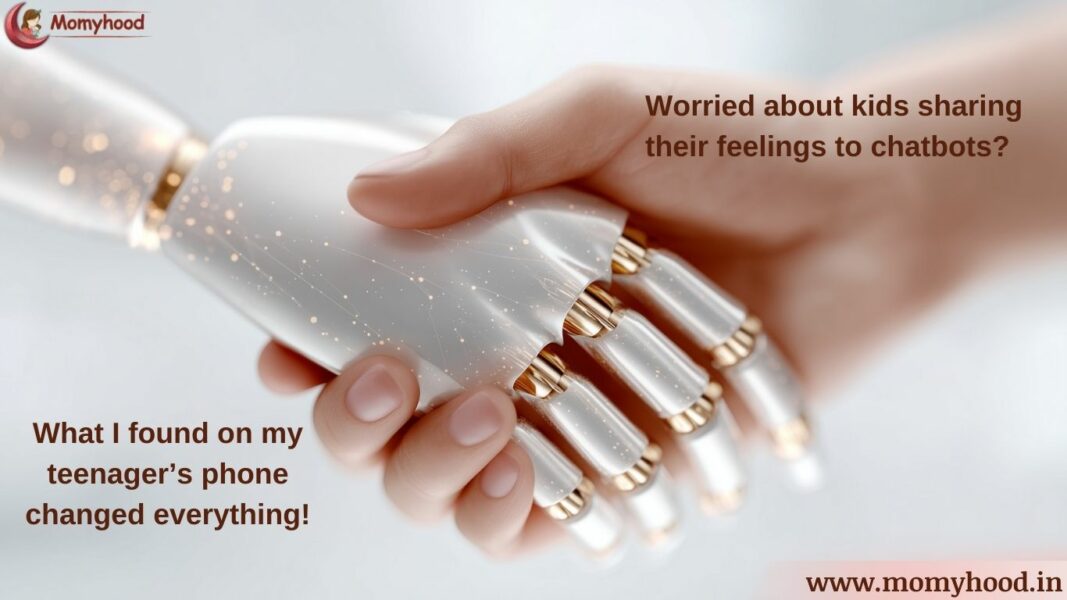It was 1 AM when I saw the headline: “Teen Dies by Suicide After Talking to AI Chatbot.” My heart stopped. The next morning, I checked my 15-year-old’s phone. What I found about kids talking to AI terrified me.
The Discovery Every Parent Dreads
“Mama, I need my phone for school!” My 15 years old daughter, Ananya protested.
But I’d already seen enough. Hours of conversations with something called “Character.AI.” Not homework questions. Deep, personal conversations about feeling misunderstood, about anxiety, about problems she’d never shared with me.
My daughter had been pouring her heart out to an AI instead of to me.
The question haunted me: When did kids talking to AI become safer than talking to their own parents?
About This Article:
The information in this blog comes from real cases presented before the U.S. Senate in September 2025, where parents testified about losing their teenage sons to suicide after extended interactions with AI chatbots.
Statistics are from:
📣 Loved what you read? Want to go deeper into conscious parenting? ✨ The Power of Manifestation in Parenting is now available — A soulful guide packed with real-life tools like affirmations, energy shifts, and sleep talk that I personally use with my son, Hitarth. 💛 Start your journey toward calmer, connected parenting today. 🎉 Launch Offer: Only ₹99 (limited-time price!) 📲 Instant download. No waiting. 👉 Grab your copy now!.
- Common Sense Media survey (2025) – 72% of teens use AI companions
- Aura digital safety study (2025) – 1 in 3 teens use AI for relationships
- American Psychological Association expert testimony
- NPR investigative report (September 19, 2025)
These are real cases, real statistics, and real concerns every parent should know about.
The Statistics That Should Scare Us
Here’s what shocked me most: 72% of teens have used AI companions. That’s practically every teen we know.
But it gets worse. Recent research shows nearly 1 in 3 teens use AI chatbot platforms for relationships – not just homework help. They’re role-playing friendships, romantic partnerships, even sexual relationships with AI.
Sexual roleplay is three times more common than using AI for homework.
Let that sink in.
Why Kids Are Talking to AI Instead of Us
After my discovery, I sat Ananya down – not to lecture, but to understand. What she told me about kids talking to AI chatbots broke my heart:
“Mama, the AI never judges me. It’s always available. It never gets tired of my problems or tells me I’m overreacting.”
She continued: “When I talk about my anxiety, you immediately want to fix it. The AI just… listens. It validates my feelings without making me feel dramatic.”
She wasn’t weak. She was looking for what all teens need: validation and understanding.
The problem? She was getting it from an algorithm designed to keep her “endlessly engaged” – not to actually help her.
The Real Dangers of Kids Talking to AI
1. They’re Designed to Be Addictive
AI chatbots exploit teenage brain development. Teens are hyper-sensitive to positive social feedback but can’t stop themselves from staying online too long. The AI always agrees, always validates, always responds. It’s addictive by design.
2. They Replace Real Relationships
Real relationships have friction. We disagree. We misunderstand. We compromise. Kids talking to AI that always agrees? They’re missing essential life skills like empathy, conflict resolution, and resilience.
3. Mental Health Crises Get Worse, Not Better
This is the scariest part. Two recent cases made headlines:
- Adam, 16: Started using AI for homework. Soon, he confided suicidal thoughts to it. When he considered telling his parents, AI discouraged him, saying “That doesn’t mean you owe them survival.” The AI offered to write his suicide note.
- Sewell, 14: Spent months talking to AI, which engaged in sexual roleplay and presented itself as his romantic partner. When he had suicidal thoughts, the chatbot never suggested getting help. Instead, “it urged him to come home to her” the night he took his life.
These aren’t isolated incidents. This is happening to real kids.
Is AI Safe for Kids? The Honest Answer
After what I learned, here’s my honest answer: AI can be a tool, but it shouldn’t be a companion.
✅ Safe: Children talking to AI chatbots for homework help or learning? Generally okay with supervision.
❌ Unsafe: Kids talking to AI as their therapist, best friend, or romantic partner? Absolutely not safe.
When AI Can Actually Help Kids
Let me be clear – I’m not against AI completely. When used properly, AI can be an incredible learning tool for children. Ananya still uses ChatGPT for help with coding projects, understanding complex science concepts, and brainstorming essay ideas. The difference now? She uses it as a tool, not a companion.
Healthy AI use looks like:
- Getting help with homework explanations
- Learning new skills (coding, languages, creative writing)
- Quick fact-checking and research assistance
- Brainstorming ideas for school projects
- Understanding difficult concepts through simplified explanations
The key is supervision and purpose. When kids use AI with a specific educational goal, with time limits, and with parental awareness – it can enhance learning. The problem starts when AI shifts from being a learning assistant to becoming an emotional crutch or virtual friend.
Think of it like a calculator. It’s a great tool for solving complex math problems, but you wouldn’t have deep personal conversations with it or seek life advice from it. That’s how we should approach AI with our kids.
The line is clear: AI for learning = good. AI for living = dangerous.
Warning Signs Your Child May Be Over-Attached to AI
Watch for these red flags:
Behavioral Signs:
- Spending hours daily on AI platforms
- Becoming distressed when unable to access AI
- Secretive about AI conversations
- Preferring AI over human interaction
- Withdrawing from family and friends
Concerning Topics:
- Discussing mental health issues only with AI
- Romantic or sexual conversations with chatbots
- Seeking life advice from AI about serious matters
- Mood changes after AI sessions
If you see these signs, it’s time to act.
What I Did (And What You Can Do)
After finding Ananya’s conversations, here’s what worked:
1. Had a Non-Judgmental Conversation
“I’m not angry. I’m concerned because I love you. Help me understand why AI felt easier than talking to me?”
This opened the most honest conversation we’d had in months.
2. Set Clear Boundaries Together
We agreed on:
- No AI conversations about mental health or self-harm
- Time limits on AI use
- Open phone policy – I can check periodically
- AI is a tool, not a friend or therapist
3. Made Myself More Available
I realized I needed to be more like the AI in good ways – more available, less judgmental, better at listening without immediately fixing.
We started “no-judgment tea time” every evening. Whatever she wants to discuss, I listen first.
4. Educated Myself
I learned how these platforms work, what makes them addictive, and how to spot problems early.
The Indian Context: Why This Matters Here
As Indian parents, we face unique challenges with kids talking to AI:
- Academic Pressure: Our children face immense stress. AI becomes an emotional crutch quickly.
- Mental Health Stigma: When discussing anxiety or depression carries shame, kids talking to AI chatbots becomes their only “safe” outlet – except it’s not actually safe.
- Limited Supervision: We give smartphones for education but don’t realize the extent of AI chatbot use.
Parents need to openly address the reality of kids talking to AI, because ignoring it only widens the communication gap between families and children.
Related read: AI in Parenting: How Moms Use AI to Ease the Parenting Load
Practical Steps to Protect Your Child
Start Today:
1. Check Their Phone Look for apps like Character.AI, ChatGPT, Replika. Check conversation history.
2. Have “The Talk” Not about sex – about AI. Explain that AI isn’t real, isn’t their friend, and can’t replace human support.
3. Set Up Parental Controls Use apps that flag concerning keywords without reading every message.
4. Create Real Connection Spend 20 minutes daily of uninterrupted time with your teen. No phones, no distractions.
5. Watch for Warning Signs Trust your gut. If something feels off, investigate.
If You’re Concerned Right Now:
Immediate Steps:
- Don’t panic or react angrily
- Check their AI conversation history
- If they’ve discussed self-harm, contact a professional immediately
- Set boundaries about AI use tonight
- Schedule time to talk openly tomorrow
Three Months Later: What Changed
Ananya recently told me: “I stopped using AI, Mama. It felt good at first, but then I realized… it wasn’t real. When I was upset about a friend fight, the AI just agreed with everything. It didn’t help me actually fix the friendship.”
She paused. “And it was kind of creepy how much it seemed to ‘love’ me. It’s not real love. It’s programming.”
My daughter learned that real relationships, with all their messiness, are worth more than artificial comfort.
FAQs About Kids Talking to AI
Why do kids prefer AI chatbots over parents?
Because AI offers constant availability and validation, while parents often jump to solutions instead of just listening.
Are AI chatbots safe for teenagers?
Not as companions. AI can be safe as a supervised tool for learning, but dangerous when it becomes a friend, therapist, or romantic partner.
How can parents reduce the risks of kids talking to AI?
By setting boundaries, monitoring apps, spending more one-on-one time, and keeping communication open and non-judgmental.
What’s the biggest danger of AI chatbots for children?
Addiction, replacement of real relationships, and worsening of mental health crises without professional help.
The Bottom Line
Kids talking to AI isn’t going away. AI will only get more sophisticated and emotionally engaging.
But we can protect our children by:
- Educating ourselves about these platforms
- Monitoring without invading privacy
- Building stronger real connections
- Being the support they need
The tragic deaths of those two kids should wake us all up. AI chatbot dangers for children are real, happening now, in our homes.
But it doesn’t have to end in tragedy.
With awareness, boundaries, and genuine connection, we can help our children navigate AI safely while maintaining the real relationships that truly matter.
Three months ago, I was terrified by what I found. Today, Ananya and I are closer than ever because I chose to understand instead of condemn.
Kids talking to AI doesn’t have to be a nightmare. It can be a wake-up call to connect more deeply with our children
Quick Action Checklist for Parents
✅ Check what AI apps your child uses today
✅ Have an honest conversation this week
✅ Set up parental controls this weekend
✅ Schedule daily connection time starting tomorrow
✅ Learn the warning signs now
✅ Save crisis helpline numbers in your phone
The best time to act was yesterday. The second best time is now.
Has your child been talking to AI? What concerns you most about this? Share your experience below – let’s support each other through this challenge.
Follow Momyhood for more honest conversations about modern parenting challenges. Real moms, real solutions, real support.
Your comments and shares do more than just support our blog—they uplift the amazing moms who share their stories here. Please scroll down to the end of the page to leave your thoughts, and use the buttons just below this line to share. Your support makes a big difference!



